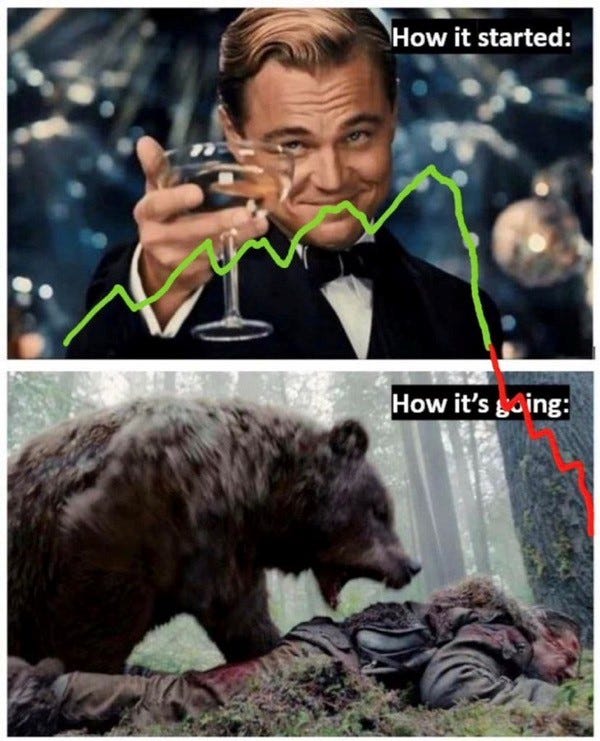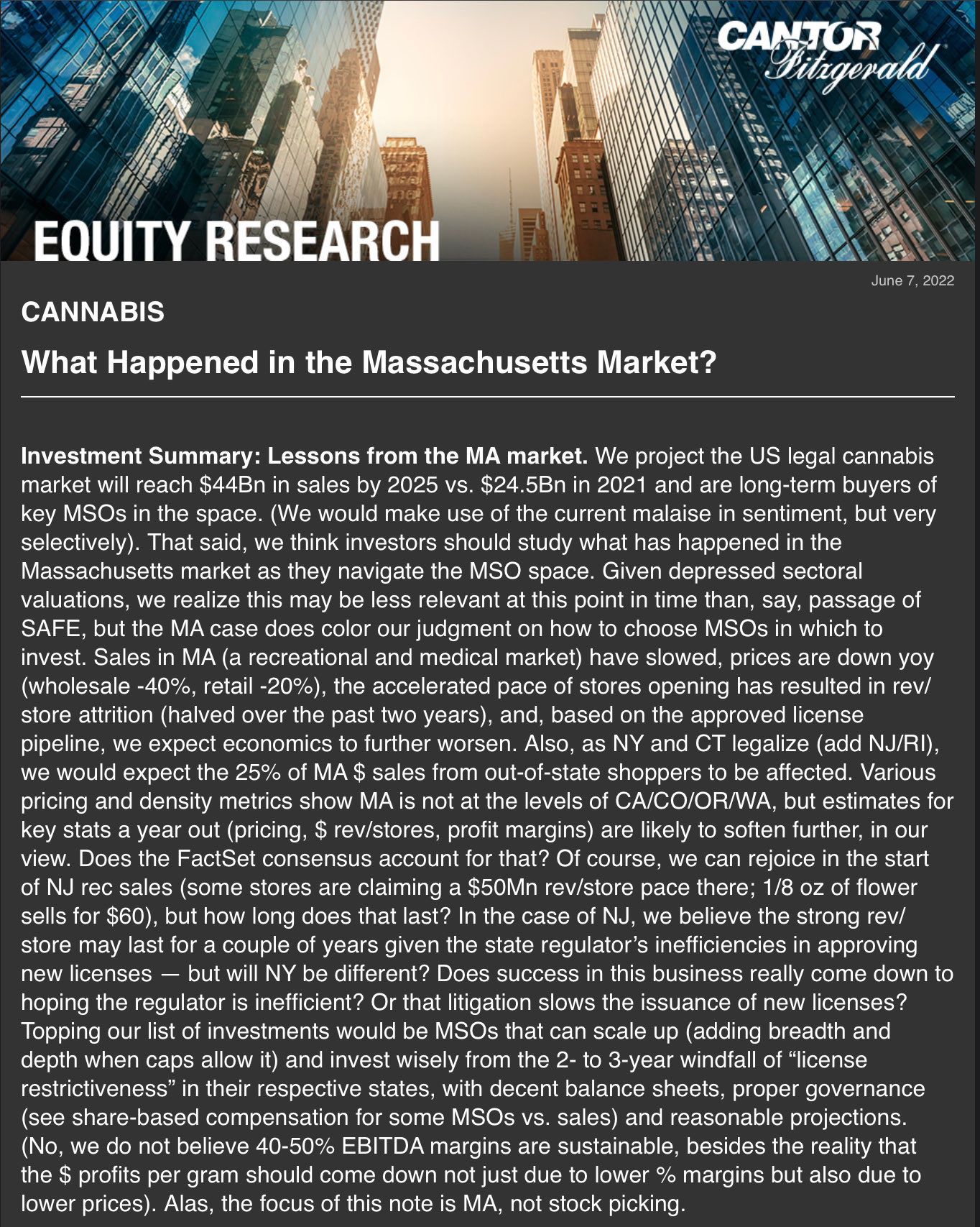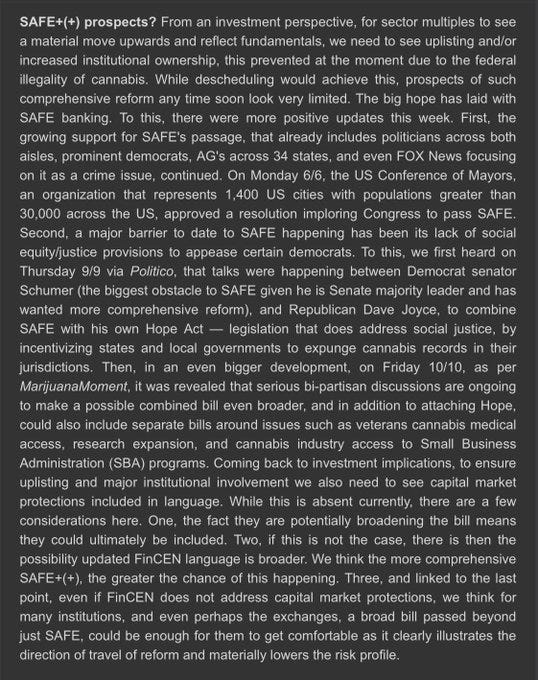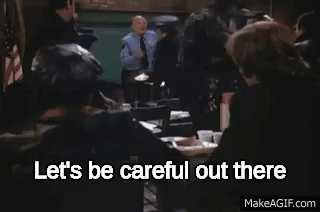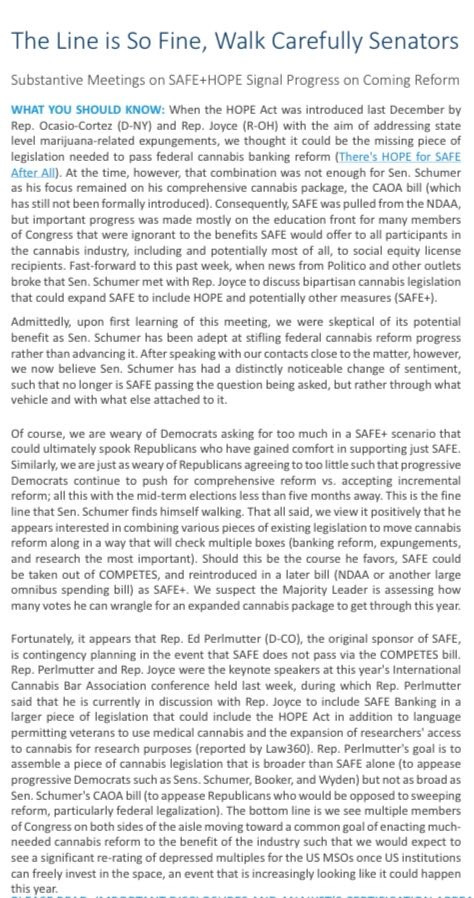It’s been a horrific fifteen sixteen months for U.S cannabis stocks…
…as retail-laden growth has gotten mauled. We’ve noted several dynamics that helped drive this complex lower and spoke about the capitulation / forced selling long before Goldman Sachs helped us visualize the pervasive pain with this single snapshot…
…but communication does little to dull the pain; and given retail investors are ~95% of US cannabis plant-touching cap tables, the downside volatility has been amplified by a host of multilinear dynamics. As is often the case after a sharp downside move, the bears have grown louder, their arguments seemingly more coherent.
Croptober / the illicit market will continue to outwit the legal framework.
Prices are artificially inflated, creating unsustainable margins in limited license states.
Bureaucrats and politicians have mucked up the industry, causing monster delays at the state level and irreconcilable differences at the federal level.
And there’s the broader concerns ranging from the Canadian cannabis precedent to the death of the American consumer; the evident recession and societal depression; the social unrest, tribalism and hell, let’s call it what it is: the stealth Civil War.
There are no crystal balls and the last year certainly demonstrated that. If we covered our screens and focused only on the substantial progress across the U.S landscape and the many successes by the pioneers and entrepreneurs who continue to set themselves apart from their peers, we would think to ourselves, “what a time to be alive!”
Instead, many early adopters, investors and operators are fatigued if not despondent and tbh it’s hard to blame them after 15 16 straight months of relentless selling that took 75% off pretty much every plant-touching cannabis company.
Meanwhile, industry evolutions continue apace.
New Jersey surpassed $24M in adult-use sales the first month despite limited stores / form factors, and nineteen more adult-use locations were recently approved.
An Illinois judge ruled on the 185 social equity licenses that have been hung up in the court system, unlocking a billion-dollar opportunity for in-state operators.
New York and Pennsylvania lawmakers approved 280E tax exemptions.
Rhode Island became the 19th state to legalize adult-use cannabis.
Mississippi medical cannabis sales will begin by year-end.
A California cultivation tax holiday is proposed / likely to begin next month.
Connecticut received over 15,000 applications for retail and is on track for 2H22.
And in terms of the underlying fundamentals, we believe that recent concerns…
…while valid, should be taken in the proper context, at least for the top operators who are executing against their strategy / are solid stewards of capital.
[we’re largely in agreement with much of what Pablo shared above; this exercise is to alleviate concerns regarding the viability of the U.S cannabis industry as an emerging asset class / long term investment theme]
[we’re attempting to showcase the margin opportunities in mature markets are still able to generate above-average profitability]
As with any industry, only the strong will survive and thrive and many won’t make it to the other side. It’s a sad reality but paradoxically one that will help shape the self-regulating, free-market solution. Let’s dig into the math and some recent worries…
Pricing and Margins
We agree that all markets will move towards normalized pricing over time—unlimited markets obviously move faster than limited license markets. As that happens, the near-term margin cushion will help fund capital expenditures / onerous tax liabilities.
[Ohio, as a limited-license medical state, is currently selling mid-grade cannabis for a blended average of $4,000/lb retail; that’s not sustainable but price / margin structure will persist until normalization]
[^ will benefit from a 3-5X revenue bump when they convert to adult-use]
We believe 50-60% Gross Margins are sustainable for top operators in mature markets for branded wholesale cannabis companies; let’s look at a few examples.
Operational COGS for Green House (GH) flower will likely average $150-300/lb depending on the scale and sophistication of the operator.
Glass House Farms ($GLASF) cultivation COGS are $0.43/gram ($190/lb) and they’re targeting $0.23/gram ($100/lb) when their 5.5M sq ft SoCal facility is operating at full scale. Average Selling Price (ASP) between $5-$8.50/gram ($23/8th, $40/¼, $160/ounce) illustrates the profit margins with a low cost of cultivation and relatively high ASPs.
Indoor flower has much better margins but a smaller share of the market. We believe operational COGS for indoor flower will average $300-700/lb (depending on the scale and sophistication of the operator) and that wholesale pricing of $1,100-3,400/lb will allow retail 50%+ Gross Margin on $2,200-7,000/lb ASP, or $5-$15/gram.
[we use pricing from mature markets such as CA, OR, WA, CO. In CA, for instance, Alien Labs / Connected Cannabis is a market leader with $60-70/3.5g unit SKUs and approx. $3400/lb wholesale pricing while other operators are going out of business as flower prices decline; high quality offerings within respective price points will win]
Multi-State Operator 4Front Ventures ($FFNTF) is #3 by revenue in Washington state (Headset) and the second largest producer of flower. They are cultivating for $300/lb ($0.67/gram / $2.35/3.5g) in WA and their #1 selling SKU is a $20-25 ASP/3.5g unit.
[^not even the best part of the 4Front story IMO]
[non-best in breed indoor cultivators will struggle to compete with the quality of top-tier GH operators ($4-7 ASP); GH operators that can’t produce top-quality products at scale will compete w outdoor cultivators (< $0.25/gram)]
Build Out Costs for Cultivation Facilities
Cannabis cultivation/ manufacturing facilities’ ROI are driven by product quality…
…and this chart, based on data / assumptions representative of a mature market, help demonstrate that success is and will continue to be driven by producing best-in-class products within each respective targeted price / SKU segment.
[best-in-class GH operators produce flower quality that dictates higher price points / margins; poor GH operators will compete solely on price only in a race to the bottom with other low-quality offerings; same goes for indoor]
[outdoor is largely used for extraction-based products w best-in-breed competing as the lowest-tiered flower price point]
Interstate Commerce
Barring intervention from the judicial branch, interstate commerce will most likely arrive once comprehensive reform has enough votes to pass congress and be signed into law by the President. That is likely several years away, which would allow operators to hone their SOPs / further develop their brands and consumer affinity before the landscape shifts and CPG to enter the space (→ the eventual buy-build).
Illicit Market
Last year’s bumper crop on the west coast flooded the country with illicit product but we’re told half of the California’s farm leases won’t renew due to economic conditions which, coupled with a crackdown on illicit grows for water usage, should meaningfully reduce the Croptober impact next season.
[this will remain a cyclical theme that varies annually / will mitigate as other adult-use markets develop and take share]
[we believe Colorado will be representative of mature market pricing; only ~10% of the market is illicit right now, relative to Illinois, which is still ~50% illicit]
Federal Reform
While our state-led bull thesis was never predicated on federal legislation—just the understanding that it would eventually arrive—news we’ve been waiting for broke last week. Senate Majority Leader Chuck Schumer (D-NY) and Representative Dave Joyce (R-OH) are exploring a compromise that would include SAFE Banking and state-level expungements for non-violent cannabis offenses; along with federal clemencies, this would presumably help shape the criminal justice ‘+’ affixed to the banking bill.
Per the Jefferies note above, the path / sequencing of incremental federal reform is yet unknown but we remain of the view that it’ll be enacted by this Congress, which will finally begin to address many of the inequities that plagued society and these stocks.
I know it’s rough out there. Markets are cratering, the government is a shit-show and the world a hot mess; but they’ve already chased most rational human beings away from this sector and positioning is about as off-sides as it could possibly be.
Meanwhile, everything we were excited about sixteen months ago has finally come to pass, from New Jersey unleashing the tristate / east coast to the genuine specter of federal reform; and as it stands, nobody seems to give a shit.
Is this the other side of paradise, or was paradise lost? That answer may be unique to each of us but we wish you strength and lucidity as we collectively try to navigate this increasingly complex world and extremely volatile markets. May peace be with you.
Extra: Camilo Lyon @ BTIG wrote this the morning after we pubbed (6/13/22)
“we now believe Sen Schumer has had a distinctly noticeable change of sentiment, such that no longer is SAFE passing the question being asked, but rather through what vehicle and with what else attached to it.”
“expect to see a significant rerating of depressed multiples for the US MSOs once US institutions can freely invest in the space, an event that is increasingly looking like it could happen this year.”
positions / advisor $FFNTF $GLASF
h/t @Investingcom on the first image





